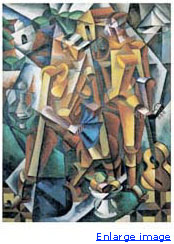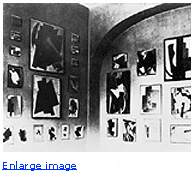
|
 |
 |

|







Order the catalogue |
 |
  Along with Udaltsova, Popova is among the
finest exponents of Cubism within the Russian avant-garde,
and her nudes and still lifes of the early 1910s
demonstrate a severity and sobriety often lacking in the
art of her more boisterous male colleagues David Burliuk
and Mikhail Larionov. Popova assimilated the Cubist
aesthetic through her lessons under Henri Le Fauconnier and
Jean Metzinger in Paris, whose formal influence is clear in
paintings such as Composition with Figures,1913.
Both students at the Parisian atelier Ac&aacuate;demie
de la Palette, Popova and Udaltsova often shared subjects
and approaches'as a comparison of their respective
paintings The Pianist and At the Piano, both 1915,
indicate. Along with Udaltsova, Popova is among the
finest exponents of Cubism within the Russian avant-garde,
and her nudes and still lifes of the early 1910s
demonstrate a severity and sobriety often lacking in the
art of her more boisterous male colleagues David Burliuk
and Mikhail Larionov. Popova assimilated the Cubist
aesthetic through her lessons under Henri Le Fauconnier and
Jean Metzinger in Paris, whose formal influence is clear in
paintings such as Composition with Figures,1913.
Both students at the Parisian atelier Ac&aacuate;demie
de la Palette, Popova and Udaltsova often shared subjects
and approaches'as a comparison of their respective
paintings The Pianist and At the Piano, both 1915,
indicate. |
 |
 |
  Still, like her fellow Amazons, Popova was
also open to other styles, such as Italian Futurism
(herItalian Still Life, 1914, is dedicated to the
Italian Futurists), the Suprematism of Kazimir Malevich,
the reliefs of Vladimir Tatlin, and even the Italian
Renaissance and the 'Orientalism' of Samarkand, a city in
eastern Russia. These many elements conspired to produce
Popova's special resolutions of form and color crystallized
in the dynamic reliefs and architectonic paintings of the
late 1910s. Still, like her fellow Amazons, Popova was
also open to other styles, such as Italian Futurism
(herItalian Still Life, 1914, is dedicated to the
Italian Futurists), the Suprematism of Kazimir Malevich,
the reliefs of Vladimir Tatlin, and even the Italian
Renaissance and the 'Orientalism' of Samarkand, a city in
eastern Russia. These many elements conspired to produce
Popova's special resolutions of form and color crystallized
in the dynamic reliefs and architectonic paintings of the
late 1910s.
Like Exter and Stepanova, Popova recognized the impasse
that abstract painting had reached and, after contributing
to the 5 x 5 = 25 exhibition in 1921, devoted her
energies primarily to stage, textile, and book design. In
fact, along with Stepanova, Popova transformed the very
perception of theater decoration in her resolutions for
director Vsevolod Meierkhold's bold productions. With her
sudden and tragic death, the avant-garde firmament was
deprived of one of its brightest stars.
|
 Above left: Posthumous
exhibition of Popova's work, Moscow, 1924. Above left: Posthumous
exhibition of Popova's work, Moscow, 1924.
|
Above right: Composition with Figures, 1913. Oil on
canvas, 160 x 124.3 cm. State Tretiakov Gallery,
Moscow.
|











